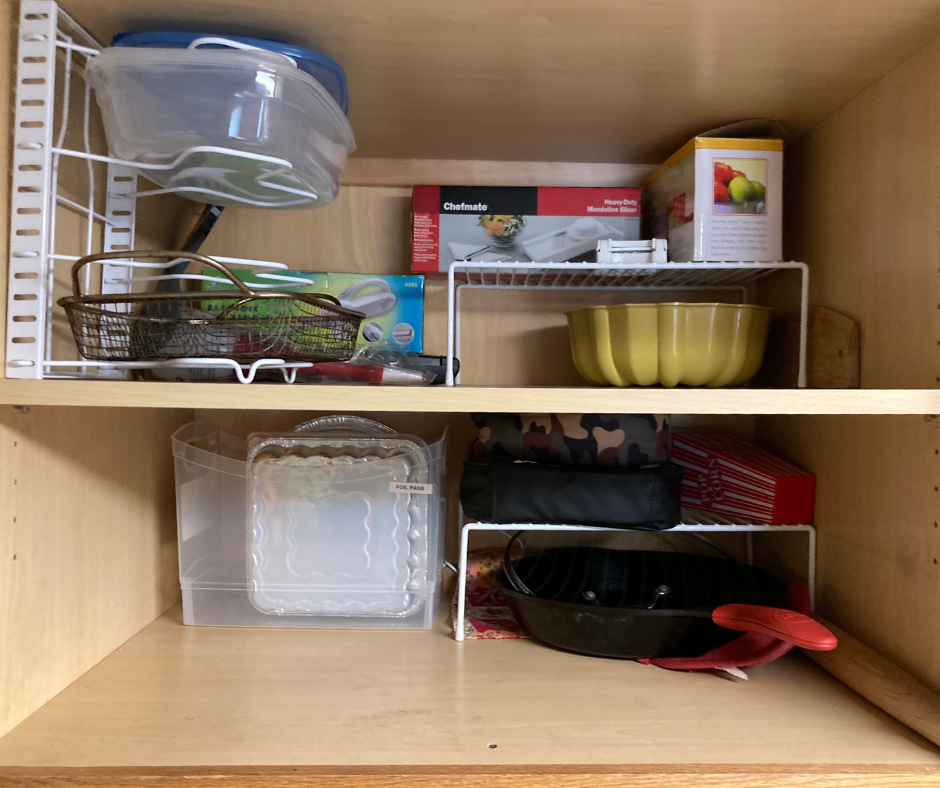Strategic Organization Vol. 7: Real Life
I want the spaces I work on to be beautiful. I do. But more importantly, I want them to work.
Today we’re taking a look inside a real life cabinet — that awkward one over the fridge, to see how it can work in a real house where real people live.
Many of us have one of these and we’re never quite sure what to do with it. It’s too high for the cereal, too awkward to store the fancy glassware, and easily becomes a black hole where Halloween candy you’re hiding from the kids goes to die.
Disclaimer: Guys, I’m not a photographer. And I’ll never be an influencer because I promise I won’t take the time to learn or purchase the equipment needed for beautiful photos. Forgive me. I’d rather be decluttering.
Here we go.
All the organizing products are either from Walmart or the homeowner’s stash. This was accomplished after decluttering and with a fair amount of trial and error Tetris.
Top Shelf
The items on the top left used to be nested, and were a huge pain to retrieve. Now it’s easy to see what’s there (and not there — need a foil pan refill). Screwing the unit to the cupboard would stabilize it, but we weren’t ready for that commitment quite yet.
Organized cabinet
The bin in the top center (under $6!) holds less frequently used small items, and is labeled so there’s no need to dig through a bunch of stuff to see what’s in there. “Garlic thing” and “slap chop” are descriptive-enough labels for this family!
The stock pot’s accessibility is proportionate to how often it’s used, which is really the main thing we ask from an organizing system.
Bottom Shelf
On the lower shelf are more frequently used items, and at least the front items are reachable by most members of the family. The bin on the left holds small items that are used almost daily and don’t really fit anywhere else in the kitchen.
The salad spinner is the most often-used item here, and therefore gets prime real estate it deserves.
What’s Back There?
You can see items behind the front layer. I hope it is obvious that these are less frequently used items, but let’s pull out the front row and see what’s back there.
The homeowner had those shelves, but similar ones are available almost everywhere: Menards, Amazon, Walmart, etc. Bonus tip: they also work great inside the freezer!
Yet another clear Walmart bin holds smaller foil pans that used to tumble out violently any time they were bumped. Notice the label on a different side of the bin, based on how it is placed in the cabinet. Little details like this make a big difference, especially if more than one person is looking for things in here.
What’s hiding in the back?
Cast iron is hard to store, guys. It just is. This is not ideal, but it’s a small kitchen and this is where it fits. The shelf helps to not waste usable cabinet space.
The lunchboxes are only there for the summer, and don’t really get put away during the school year. Live in the season, pals!
The items in the back of the top section are rarely used, but not yet ready to be decluttered. (You can stay, apple peeler used only in September.) They’re hard to get to, but stored in a space that makes sense and makes other items more accessible, which is what matters here and what works for this family.
That’s it! Not sexy but hopefully the explanations help you envision how an awkward space of yours might work.
Remember, consultations are always free, so if you’d like to tackle a space like this, just reach out and I’m happy to take a look. Let’s be the Boss of Our Awkward Spaces!



